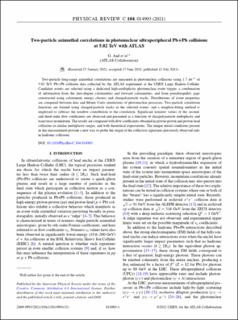Two-particle azimuthal correlations in photonuclear ultraperipheral Pb+Pb collisions at 5.02 TeV with ATLAS
Aad, Georges; Abbott, Brad; Abbott, Dale C.; Abed Abud, Adam; Abeling, Kira; Abhayasinghe, Deshan Kavishka; Abidi, Syed Haider; AbouZeid, Ossama Sherif Alexander; Abraham, Nadine L.; Abramowicz, Halina; Bjørke, Kristian; Bugge, Magnar Kopangen; Cameron, David Gordon; Catmore, James Richard; Garonne, Vincent; Gramstad, Eirik; Heggelund, Andreas; Hellesund, Simen; Håland, Even Simonsen; Morisbak, Vanja; Oppen, Henrik; Ould-Saada, Farid; Pedersen, Maiken; Read, Alexander Lincoln; Rye, Eli Bæverfjord; Røhne, Ole Myren; Sandaker, Heidi; Vadla, Knut Oddvar Høie; Buanes, Trygve; Djuvsland, Julia Isabell; Eigen, Gerald; Fomin, Nikolai; Latour, Bertrand Pascal Christian; Lee, Graham Richard; Lipniacka, Anna; Stugu, Bjarne Sandvik; Træet, Are Sivertsen; Abreu, Henso; Abulaiti, Yiming; Abusleme Hoffman, Angel C.; Acharya, Bobby S.; Achkar, Baida; Adam, Lennart; Adam-Bourdarios, Claire; Adamczyk, Leszek; Adamek, Lukas; Adelman, Jareed; Adigüzel, Aytül; Adorni, Sofia; Adye, Tim
Journal article, Peer reviewed
Published version

Åpne
Permanent lenke
https://hdl.handle.net/11250/2986018Utgivelsesdato
2021Metadata
Vis full innførselSamlinger
Sammendrag
Two-particle long-range azimuthal correlations are measured in photonuclear collisions using 1.7 nb−1 of 5.02 TeV Pb+Pb collision data collected by the ATLAS experiment at the CERN Large Hadron Collider. Candidate events are selected using a dedicated high-multiplicity photonuclear event trigger, a combination of information from the zero-degree calorimeters and forward calorimeters, and from pseudorapidity gaps constructed using calorimeter energy clusters and charged-particle tracks. Distributions of event properties are compared between data and Monte Carlo simulations of photonuclear processes. Two-particle correlation functions are formed using charged-particle tracks in the selected events, and a template-fitting method is employed to subtract the nonflow contribution to the correlation. Significant nonzero values of the second- and third-order flow coefficients are observed and presented as a function of charged-particle multiplicity and transverse momentum. The results are compared with flow coefficients obtained in proton-proton and proton-lead collisions in similar multiplicity ranges, and with theoretical expectations. The unique initial conditions present in this measurement provide a new way to probe the origin of the collective signatures previously observed only in hadronic collisions.
